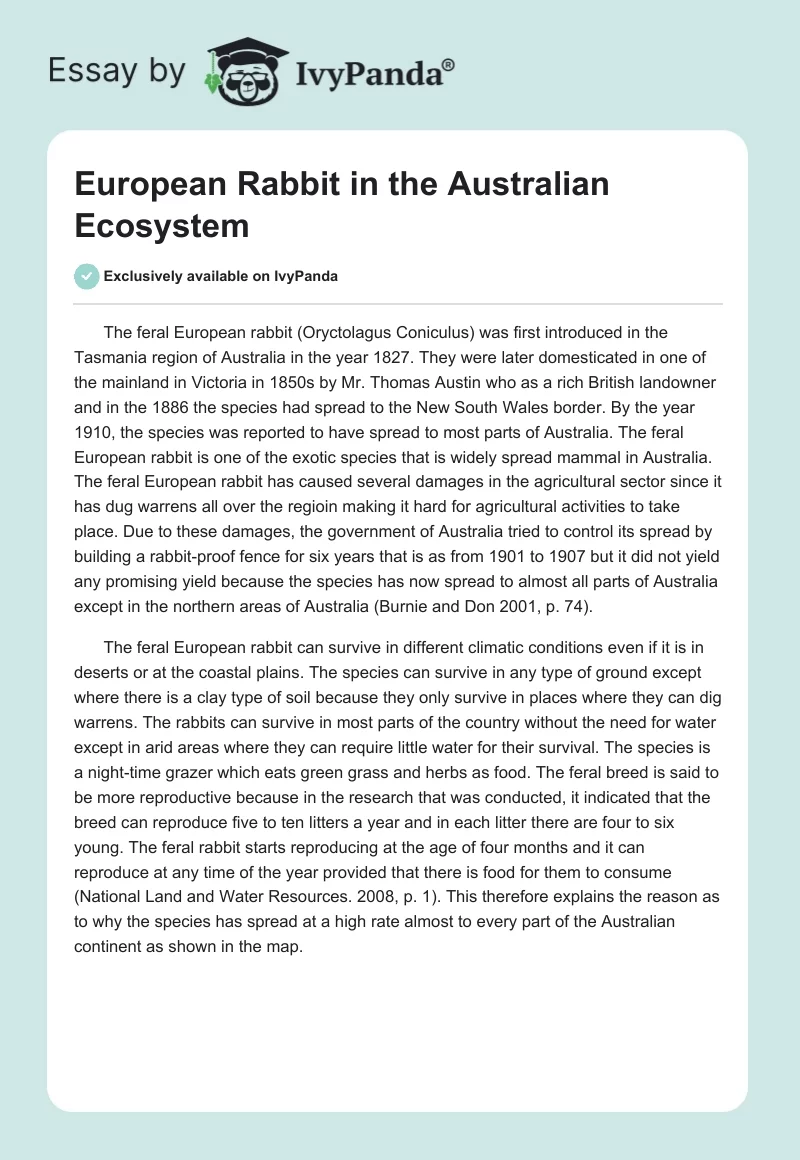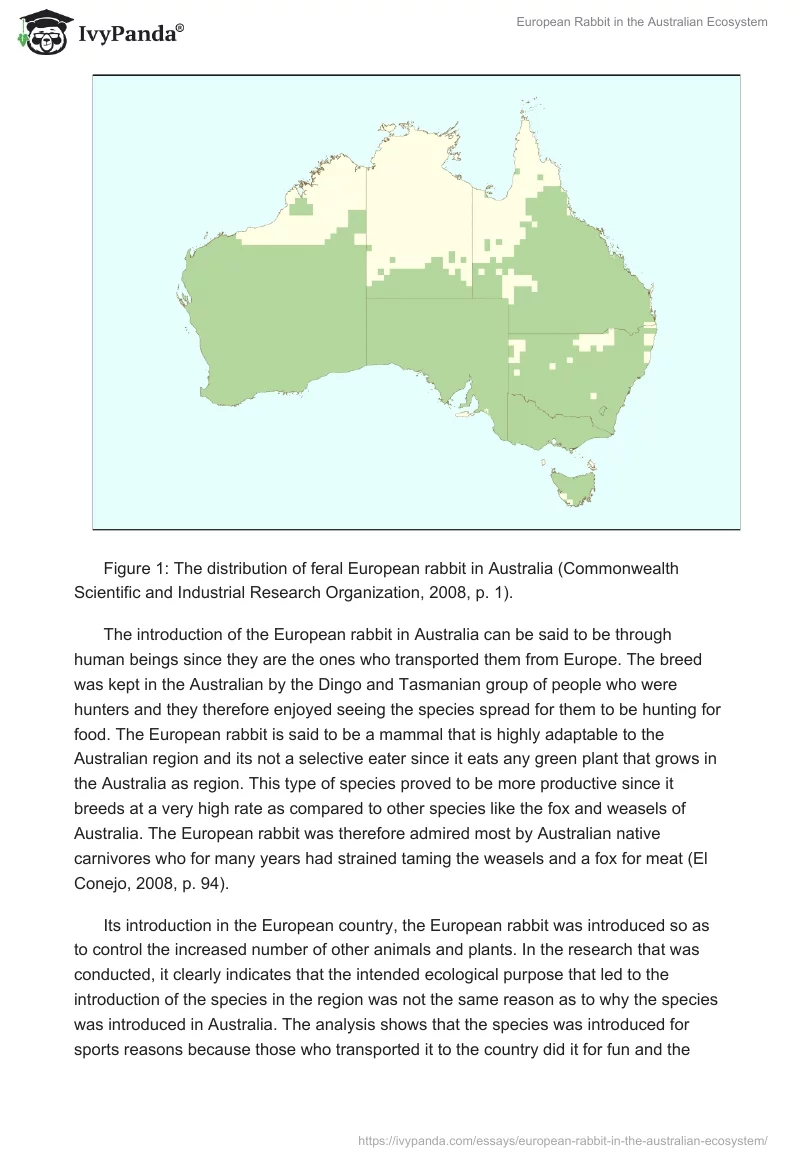The feral European rabbit (Oryctolagus Coniculus) was first introduced in the Tasmania region of Australia in the year 1827. They were later domesticated in one of the mainland in Victoria in 1850s by Mr. Thomas Austin who as a rich British landowner and in the 1886 the species had spread to the New South Wales border. By the year 1910, the species was reported to have spread to most parts of Australia. The feral European rabbit is one of the exotic species that is widely spread mammal in Australia. The feral European rabbit has caused several damages in the agricultural sector since it has dug warrens all over the regioin making it hard for agricultural activities to take place. Due to these damages, the government of Australia tried to control its spread by building a rabbit-proof fence for six years that is as from 1901 to 1907 but it did not yield any promising yield because the species has now spread to almost all parts of Australia except in the northern areas of Australia (Burnie and Don 2001, p. 74).
The feral European rabbit can survive in different climatic conditions even if it is in deserts or at the coastal plains. The species can survive in any type of ground except where there is a clay type of soil because they only survive in places where they can dig warrens. The rabbits can survive in most parts of the country without the need for water except in arid areas where they can require little water for their survival. The species is a night-time grazer which eats green grass and herbs as food. The feral breed is said to be more reproductive because in the research that was conducted, it indicated that the breed can reproduce five to ten litters a year and in each litter there are four to six young. The feral rabbit starts reproducing at the age of four months and it can reproduce at any time of the year provided that there is food for them to consume (National Land and Water Resources. 2008, p. 1). This therefore explains the reason as to why the species has spread at a high rate almost to every part of the Australian continent as shown in the map.

The introduction of the European rabbit in Australia can be said to be through human beings since they are the ones who transported them from Europe. The breed was kept in the Australian by the Dingo and Tasmanian group of people who were hunters and they therefore enjoyed seeing the species spread for them to be hunting for food. The European rabbit is said to be a mammal that is highly adaptable to the Australian region and its not a selective eater since it eats any green plant that grows in the Australia as region. This type of species proved to be more productive since it breeds at a very high rate as compared to other species like the fox and weasels of Australia. The European rabbit was therefore admired most by Australian native carnivores who for many years had strained taming the weasels and a fox for meat (El Conejo, 2008, p. 94).
Its introduction in the European country, the European rabbit was introduced so as to control the increased number of other animals and plants. In the research that was conducted, it clearly indicates that the intended ecological purpose that led to the introduction of the species in the region was not the same reason as to why the species was introduced in Australia. The analysis shows that the species was introduced for sports reasons because those who transported it to the country did it for fun and the other group of hunters provided a favourable environment for them to spread so that they can continue with their hunting activity (Schepmans 2009, p. 24).
Since the introduction of the feral European rabbit in Australia, the mammal has virtually reduced the number of other predators in the region as well as reduced the number of many plant species in the region at large. This species has been reported as an animal that has degraded the land because it digs warrens causing soil erosion which makes it hard for people to use the land for production purposes. The feral rabbit ring back trees and shrubs as well as eat seeds and seedlings making it impossible for the plants to regenerate. This has led to the extinction of several species of plants as well as animals since the rabbits eat even the small animals that live in the soil. Another threat that the feral European rabbit has into the Australia, is that apart from affecting the ecology, it has really affected the economy of the country. This is because the species has been competing over the green herbs with sheep and goats and this has resulted in a decreased number of goats and sheep in the continent that the regions across Australia no longer produce wool etc (Burnie and Don 2001, p. 78).
Several methods ranging from biological, mechanical and chemical have been used in controlling the spread of the feral European rabbit have been implemented by the government of Australia but they have not yet reached the target effectively. The first method that was implemented was mechanical, which was introduced after a few years of its introduction into the country where hunters were told to hunt the rabbits and they were paid in response to the number of rabbit trails that he/she presented. The destruction of warrens was also another mechanical way of controlling the species in Australia. Millions of dollars were used to implement this but it did not succeed to prevent its spread. The chemical method has been used in the control of this species by poisoning using sodium flour acetate where rabbits were trapped and killed. These two methods killed millions of rabbits but still they did not come to extinction (Bryant, 2006, p. 56).
The government of Australia has come up with the biological method of control where it has introduced the myxoma virus which infects rabbits only. This method proved to be effective because it managed to kill more than ninety percent of the rabbits but the few that developed resistance survived and again reproduced increasing in a large number. Another biological method that has been used is the calicivirus disease which also infects rabbits only. This disease yielded the expected results in places where the climate is wet but in dry areas the rabbits were not infected as such (El Conejo 2008, p. 104).
To conclude, it has been known that the effective way of controlling the feral rabbits in Australia requires an integration of more than one method of control. This is because when a single technique is used in isolation, it gives a room for those rabbits not trapped to regenerate hence difficult to eliminate them from the region. It is therefore advisable to carry out thorough research that will give results on the methods to be integrated for the expected results to be achieved.
References
Bryant, P 2006, Biodiversity and Conservation: Exotics in Australia and New Zealan, Routledge, London.
Burnie, D & Don, W 2001, Smithsonian Institution ANIMAL: The Definitive Visual Guide to the World, Dorling Kindersley Ltd, United Kingdom.
Commonwealth Scientific and Industrial Research Organization (CSIRO) 2008, Environmental damage by wild rabbits in Australia and New Zealand, Web.
El Conejo, T 2008, Economic and ecological impact of rabbits – “BREEDING LIKE RABBITS”: Control of the rabbit in Australia. Rockhampton: CQU Press.
National Land & Water Resources, 2008, An audit assessing invasive animals in Australia: Feral animals on offshore islands, Web.
Schepmans, F, 2009, Biotechnology Australia: Case study: European rabbits in Australia, Loydon, London.


